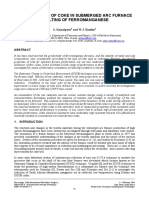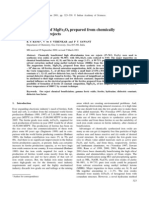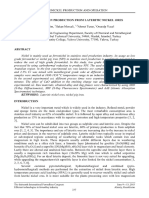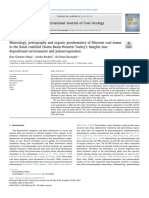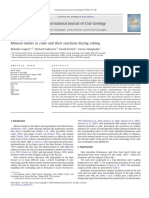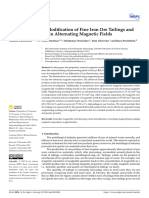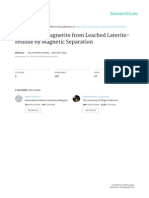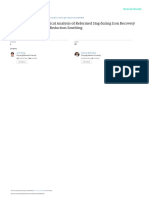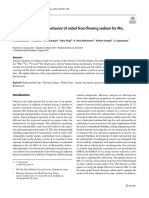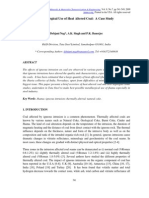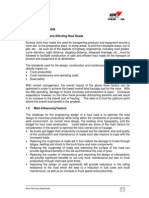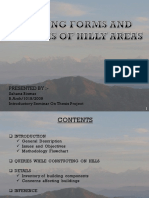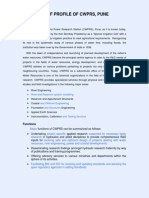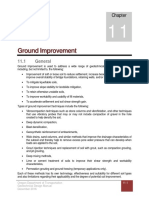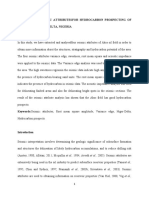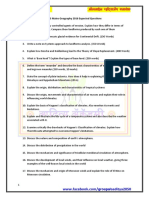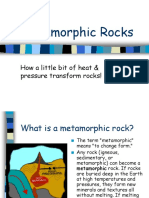Article 1 PDF
Article 1 PDF
Uploaded by
jeisCopyright:
Available Formats
Article 1 PDF
Article 1 PDF
Uploaded by
jeisOriginal Title
Copyright
Available Formats
Share this document
Did you find this document useful?
Is this content inappropriate?
Copyright:
Available Formats
Article 1 PDF
Article 1 PDF
Uploaded by
jeisCopyright:
Available Formats
International Journal of Scientific Engineering and Technology (ISSN : 2277-1581)
Volume No.3 Issue No.8, pp : 1043-1046 1 Aug 2014
Magnetic Concentration of Iron in Lateritic Soils from Kamahuha, Murang’a
County, in Kenya using Carbon Monoxide Generated In-Situ
Njoroge, P. W.1*., Mutembei P. K1., Wachira, J. M.2 and Wanjau, R. 1
1
Department of Chemistry, School of Pure and Applied Sciences, Kenyatta University, Nairobi, Kenya.
2
Department of Chemistry, Faculty of Science, Embu University college.
Corresponding author’s email; Waithakanjoroge040@gmail.com.
Abstract: Chemical and Mineral Analyses of laterites from sixty years later, this situation has not changed. At the same
selected sites in Kamahuha area of Murang’a County, in the time, we note that furthermore, the country has been spending a
Republic of Kenya, have been carried out with particular lot of money annually to import iron and iron-made products.
interest in the levels of iron and the type of minerals the iron is Thus, according to data published by United Nations
present in. A laterite/charcoal mixture was heated in the Commodity Trade Statistics Database, during the years 2008,
temperature range 500-700OC as a slow current of air was 2009 and 2010, the country imported iron-made products valued
passed through the hot mixture, the material cooled and the at, US dollars 102,283,716, 136,512,664 and 148,992,169
iron-containing mineral picked with a permanent magnet. respectively[6]. These products do not include imports of items
Elemental Analysis, which was done on both the raw and such as vehicles and Heavy machinery[7] . Ironically, some of
concentrated samples was carried out using, Atomic the iron-made products imported to Kenya have been
Absorption Spectroscopy (AAS). The Analyses also showed manufactured using ores with much lower percentage of iron
that whereas the level of iron in the raw laterites was in the than the Kenyan Ores. A specific example of such ores is the
range 28-35, in the magnet –separated product, the level had iron from Frodingham, UK, which contains only 18-25% iron
increased to 55-62% depending on several factors such as how [4]. This example has been cited because, when Kenya was a
efficiently the laterite-charcoal mixture had been mixed and British Colony, practically all iron-made imports came from
the length of time of heating.The nature of the minerals Britain.
present was determined using a Brucker D2
PhaserDiffractometer. In the raw laterites, iron was present as Previously, iron in the minerals goethite and haematite has been
the minerals goethite, FeO.OH and haematite, Fe2O3. These concentrated using froth flotation with the aid of suitable
minerals have diffraction peaks at angles 2θ=21.51˚ and 2θ = frothing agents [5], [3]. More recently, Reference [6] have
54.11, respectively. On the other hand, iron in the magnet- shown that iron in the two minerals can be concentrated by
picked product was present predominantly as the mineral magnetic separation after heating the laterites in the temperature
magnetite, Fe3O4, as shown by presence of a characteristic range 400-700oC at a current of CO/CO2 in a molar ratio of 1:3.
peak at 2θ = 36˚. The results of this study show that iron in In this paper, we wish to report the results of a study undertaken
laterites can be concentrated by magnetic separation after to find out whether similar results can be obtained by generating
passing compressed air over hot charcoal laterite mixture. the CO in situ. Thus, instead of using separate gas cylinders, one
with CO and another one with CO2, the laterites were mixed
Key Words: Hematite, Laterites, magnetic concentration, with charcoal, heated in the temperature range 500-700oC as a
Magnetite current of air is passed through the hot mixture, cooling the
INTRODUCTION material and using a permanent magnet to separate magnetite
from the cooled mixture. Whereas positive results in our study
Kenya has several geologically-documented iron ore deposits, will definitely impact positively towards achieving Kenya’s
many of them known even during the period the country was a Vision 2030, it should definitely have universal application. It is
British colony[1]. For example, there is a large lateritic deposit simple and cost effective.
in Lela, West of Kisumu which is estimated to contain at least
2.7x107 million cubic metres of laterites [1]. In a previous study, METHODOLOGY
it has been shown that laterites are fairly widely spread all over
the country and that they contain 15-45% iron depending on Laterite samples were collected from Kamahuha Area in
source. In these laterites, iron is present predominantly as the Murang’a County, in the Republic of Kenya in an area enclosed
minerals goethite and haematite [2]. During that study, a laterite by latitudes of 1° 12' 26'' S and 1° 13' 52'' S and longitudes 37°
sample collected from Lela showed that it contained an average 40' 40'' E and 37° 40' 12'' E from four quarries marked as K 1,
of 32% iron. It is, therefore, reasonable, to treat the Lela deposit K2, K3 and K4 in an area shown in the attached map of Kenya.
as a typical iron ore deposit since materials containing 25-68% Within a given quarry, the top soil was removed ( since it
iron are treated as iron ores [2]. In his Geological Report contained a lot of organic matter) and samples of about 1kg
published in 1952, reference [1], reported that laterites from Lela collected from three different depths of 10cm, 50cmand one
were being used for surfacing roads. We note that, well over meter on profiles already cut by the road construction
IJSET@2014 Page 1043
International Journal of Scientific Engineering and Technology (ISSN : 2277-1581)
Volume No.3 Issue No.8, pp : 1043-1046 1 Aug 2014
companies. We have confirmed the material the Ministry of RESULTS AND DISCUSSION
Roads recommends as high quality for road construction
contains well of 25% iron. The material was dried in an oven at The results of Elemental Analysis on the raw laterites and
105oC for two hours, ground to 300 microns (150 meshes) using concentrated laterites samples using AAS are summarized in
a pulverizer, Lab Disc Mill Machine. The accuracy of elemental Tables 1 and 2 respectively. A comparison of results in the two
Analysis using AAS was confirmed using Rock Standards, tables shows that, the level of iron in most raw samples was in
Syenite (SY-3) and Mount Royal Gabbro (MRG) from Canada, the range 31.5 – 39.2%. On the other hand, the level of iron in
obtained through the Ministry of Mines, Kenya. The AAS the magnet separated product was in the range 54 – 62.7%. Since
Instrument used was Spectr AA.10 model from SEANAC it is recommended that for an iron ore to be suitable for putting
Company while the weighing was done using the analytical in a blast furnace, it should contain at least 55% iron [10], it can
balance Model Mettler AJ150, X-ray fluorescence analysis was be concluded that this very simple ore treatment converts very
done using Minipal-2 version 4 PanAnalytical Model available low quality iron ore to ore grade. These results show that when
at Ministry of Mines, Kenya. The nature of Minerals present was charcoal is used as the source of the carbon monoxide that
determined using a Bruker Model D2 Phaser X-ray converts haematite to magnetite, the concentration of iron in the
Difractometer available at International Centre for Research in laterites was readily increased from about 30% in the raw
Agro-Forestry (ICRAF), Nairobi, Kenya. laterites to well over 55% in some samples and over 62% in a
number of samples using an extremely simple set –up whereby
A. Treatment of Laterites perhaps the most complex set up is the compressed air cylinder.
Fig 2 is a spectrum of Raw Laterite Sample showing Haematite
A laterite sample, usually between 150 and 300 gm was weighed and Goethite peaks while Fig 3 is the spectrum of Magnetite-
and mixed with some finely ground charcoal in different ratios, Separated laterite showing disappearance of Haematite and
eg 1:20 charcoal : laterite, put in a glass tube and the latter put Goethite peaks and well pronounced peaks for magnetite.
on a heat exchanger. (locally called Jiko in Kenya , see Figure XRD spectrum for KI showed that the laterite had the minerals,
1). The Temperature of the heat exchanger was controlled by Quartz which and a peak at 2θ = 26.20, Goethite was also present
increasing or reducing the air opening on the side of the heat and had a broad peak at 21.510, Rutile was also present and gave
exchanger and the temperature attained checked occasionally a peak at 24.80 .
with a Thermocouple. The mixture was heated to the
temperature range 500-700oC as a slow current of air was passed The minerals that gave peaks in the raw laterites include Quartz
through. After heating the mixture for 2-3hours, the tube was (SiO2), Goethite (FeO(OH), and Rutile (TiO2). When
removed from the heat exchanger, cooled and the contents concentration was carried out the peak for goethite disappeared
spread on a cardboard or newspaper. Flat plywood was placed and several peaks associated with magnetite appeared. The main
on top of the cool mixture and a permanent horse shoe magnet peaks observed in the concentrated portion were for the minerals
placed on top. When the horse shoe magnet was lifted together Quartz (SiO2), Rutile (TiO2) and Magnetite (Fe3O4).
with the cardboard, it was found that on removing the magnet
from the cardboard, the black material dropped. Finally, the
material was analyzed for the major elements and the mineral
present, as shown in figure 1.
B. Determination of Loss on Ignition (LOI)
Fig 2: XRD Spectrum of raw Sample K1
About 1.00 gram each of pulverized samples were weighed into
crucible boats and transferred into the furnace. The samples were
heated to 1,000 oC for about 6 hours to burn all organic
materials. The samples were then cooled in a desiccator, re-
weighed and the percentage difference determined [8],[9].
IJSET@2014 Page 1044
International Journal of Scientific Engineering and Technology (ISSN : 2277-1581)
Volume No.3 Issue No.8, pp : 1043-1046 1 Aug 2014
REFERENCES.
i. C.G.B. Dubois, Geological Survey of
Minerals of Kenya Bulletin 1966 No.8 pp. 79-84.
ii. N.Muriithi Iron of Samples of Black
Marrums and Red Ochres from different parts of Kenya.
Kenya Journal of Science and Technology,1985, 6: pp. 103-
108.
iii. J.A. Lepiniski, J.F. Myyers, and G.H. Geiger
in Kirk- Othmer Encyclopedia of Chemical Technology, 5 th
Ed. Wiley, 2004, Vol. 14,pp 490-529.
iv. Boltz, C. L. (1970) “Iron and Steel” in
Materials and
Technology, Longman and J.H. De Bussy, pp
Fig3:XRD Spectrum for concentration Sample K1 138.
CONCLUSION
v. H. Purwanto, B. Jeyadevan, R.Takahashi,
Iron content in laterite from kamahuha in Murang’a County is
in the range between 31.5 to 39.2 percent, iron in this laterites and J. Yagi, Recovery of magnetite from leached laterite
is found in the form of minerals goethite and heamatite. The residue by magnetic separation. Iron and Steel Institute of
levels of iron in the laterites are high enough for them to be Japan International, 2003, 14:1919-1926
termed as iron ore. Charcoal has been used used to reduce
heamatite to magnetite. Upon reduction magnetic separation vi. Kenya Vision 2030, Kenya new development
has been used to concentrate the iron to well over 62%. These blueprint covering the period 2008 to 2030, 2006. pp 6-9
laterites can therefore be used as a source of iron.
ACKNOWLEDGEMENTS vii. J. Emsley, Nature's Building Blocks: An A-Z
Guide To The Elements. Oxford University Press, 2nd
The authors of this paper are grateful to Ministry of Edition, 2011 pp. 260–261
Mining, Nairobi, Kenya, for permission to use their Research
Facilities. They are also grateful to the laboratory staff of
International Centre for Research in Agro-Forestry (ICRAF) for
assistance in running of the XRD at the ICRAF Laboratory, in
Nairobi. One of us (Njoroge P.W.) is grateful to the National
Council for Science and Technology for funding this study
project.
IJSET@2014 Page 1045
International Journal of Scientific Engineering and Technology (ISSN : 2277-1581)
Volume No.3 Issue No.8, pp : 1043-1046 1 Aug 2014
Table 1. Analysis of Raw Laterites from Different Sites using AAS (Values in %).
SiO2 Al2O3 K2 O Na2O CaO TiO2 MnO4 Fe2O3 Fe LOI
Mean± Mean± Mean± Mean± Mean± Mean±
Mean± SE Mean± SE SE SE SE SE SE Mean± SE SE
K1A 18.34±0.07 18.07±0.04 0.25±0.17 0.09±0.01 0.09±0.01 7.93±0.04 0.41±0.00 52.83±0.17 36.90 4.19±0.01
K1B 18.88±0.06 18.67±0.16 0.05±0.03 0.10±0.01 0.08±0.01 6.78±0.01 0.28±0.12 51.67±0.17 36.12 5.19±0.01
K2A 22.28±0.04 18.21±0.10 0.31±0.01 0.21±0.01 0.12±0.01 7.12±0.01 1.62±0.01 49.37±0.19 34.55 3.65±0.02
K2B 22.35±0.01 17.32±0.01 0.31±0.01 0.21±0.01 0.12±0.01 7.22±0.01 1.64±0.01 48.51±0.01 33.95 6.36±3.32
K3A 21.44±0.01 20.89±0.33 0.29±0.01 0.53±0.34 0.11±0.02 7.77±0.01 1.28±0.00 45.49±0.01 31.84 5.68±0.01
K3B 20.44±0.01 22.50±0.30 0.30±0.01 0.20±0.01 0.11±0.02 7.81±0.01 1.28±0.01 46.47±0.00 32.5 4.68±0.01
K4A 21.69±0.34 15.81±0.01 0.17±0.01 0.14±0.01 0.12±0.01 5.79±0.01 0.58±0.01 56.03±0.33 39.22 2.14±0.01
K4B 21.39±0.02 15.61±0.01 0.14±0.02 0.15±0.01 0.21±0.01 5.96±0.01 0.38±0.01 55.39±0.02 38.71 2.31±0.01
Tables 2: Levels of Iron after Concentration using Charcoal (Values in %).
SiO2 Al2O3 K2O Na2O CaO TiO2 MnO4 Fe2O3 Fe LOI
Mean±SE Mean±SE Mean±SE Mean±SE Mean±SE Mean±SE Mean±SE Mean± SE Mean±SE
K1A 4.14±0.02 6.09±0.24 0.20±0.12 0.19±0.11 0.13±0.31 8.63±0.04 0.21±0.00 76.13±0.17 53.65 4.19±0.21
K1B 4.8±0.16 8.67±0.32 0.15±0.00 0.20±0.21 0.14±0.04 7.75±0.01 0.18±0.12 76.68±0.17 54.05 3.19±0.16
K2A 5.24±0.02 8.67±0.11 0.11±0.05 0.31±0.21 0.22±0.00 7.32±0.06 0.56±0.01 79.09±0.19 55.72 3.65±0.00
K2B 6.34±0.04 7.82±0.00 0.34±0.31 0.41±0.31 0.42±0.31 7.62±0.03 0.84±0.01 80.71±0.01 56.83 1.36±0.32
K3A 5.46±0.01 7.99±0.21 0.21±0.11 0.33±0.32 0.21±0.22 8.73±0.05 0.98±0.08 78.05±0.01 54.97 1.18±0.03
K3B 6.24±0.02 8.59±0.23 0.19±0.11 0.30±0.03 0.31±0.01 8.01±0.00 .98±0.71 78.77±0.00 55.47 0.98±0.05
K4A 3.69±0.32 5.46±0.12 0.32±0.05 0.24±0.02 0.42±0.00 6.99±0.01 0.38±0.02 86.55±0.33 60.95 0.11±0.05
K4B 3.39±0.22 3.69±0.00 0.16±0.14 0.05±0.24 0.11±0.41 6.23±0.03 0.28±0.05 89.19±0.02 62.75 0.21±0.02
IJSET@2014 Page 1046
You might also like
- The Reduction of Nickel From Low-Grade Nickel Laterite Ore Using A Solid-State Deoxidisation MethodDocument7 pagesThe Reduction of Nickel From Low-Grade Nickel Laterite Ore Using A Solid-State Deoxidisation Methodjeha kunramadiNo ratings yet
- The Behaviour of Coke in Submerged Arc Furnace Smelting of FerromanganeseDocument11 pagesThe Behaviour of Coke in Submerged Arc Furnace Smelting of FerromanganeseSuljic AlminNo ratings yet
- Art 3A10.1007 2Fs40789 016 0127 0 - 2Document7 pagesArt 3A10.1007 2Fs40789 016 0127 0 - 2aprianisusilawati6No ratings yet
- The Behaviour of Coke in Submerged Arc FDocument11 pagesThe Behaviour of Coke in Submerged Arc FosamaaaNo ratings yet
- 1 - (Reference) Hydrogen Reduction of Hematite Ore Fines To Magnetite OreDocument12 pages1 - (Reference) Hydrogen Reduction of Hematite Ore Fines To Magnetite OreJoharNo ratings yet
- DownloadfileDocument8 pagesDownloadfileyo makNo ratings yet
- Dielectric Behaviour of MgFe2O4 Prepared From ChemicallyDocument8 pagesDielectric Behaviour of MgFe2O4 Prepared From ChemicallyPrashant ZadeNo ratings yet
- Nickel Pig Iron Production From Lateritic Nickel Ores PDFDocument8 pagesNickel Pig Iron Production From Lateritic Nickel Ores PDFMuhammad AfniNo ratings yet
- Experimental Investigation of Process Parameters During Graphitization of Catalytic CokeDocument10 pagesExperimental Investigation of Process Parameters During Graphitization of Catalytic CokePoulinne Ramirez JimenezNo ratings yet
- International Journal of Coal Geology 210 (2019) 103205Document22 pagesInternational Journal of Coal Geology 210 (2019) 103205Juan Guzmán SantosNo ratings yet
- Expanded Perlite Aggregate Characterization For Use As A Lightweight Construction Raw MaterialDocument12 pagesExpanded Perlite Aggregate Characterization For Use As A Lightweight Construction Raw MaterialNenad MitrovicNo ratings yet
- Lime-Magnetite Pellets (LMPS) For IronmakingDocument14 pagesLime-Magnetite Pellets (LMPS) For IronmakingJJNo ratings yet
- Lowtemp Didari2009Document8 pagesLowtemp Didari2009Zia Ru'ya HilalNo ratings yet
- Catalytic Graphitization in Nanocast Carbon Monoliths by Iron Co 2018Document37 pagesCatalytic Graphitization in Nanocast Carbon Monoliths by Iron Co 2018Poulinne Ramirez JimenezNo ratings yet
- J Fuel 2020 119228Document8 pagesJ Fuel 2020 119228Roni GustiwaNo ratings yet
- Kinetics of Copper Slag Oxidation Under Nonisothermal ConditionsDocument9 pagesKinetics of Copper Slag Oxidation Under Nonisothermal ConditionsSavio MendesNo ratings yet
- Beneficiation of Ajabanoko Iron Ore Deposit, Kogi State, Nigeria Using Magnetic MethodsDocument3 pagesBeneficiation of Ajabanoko Iron Ore Deposit, Kogi State, Nigeria Using Magnetic MethodsInfogain publicationNo ratings yet
- Magnetic Properties of Ilmenite, Hematite and Oilsand Minerals After RoastingDocument9 pagesMagnetic Properties of Ilmenite, Hematite and Oilsand Minerals After RoastingBalakrushna PadhiNo ratings yet
- Coal and Its Beneficiation Techniques: A Review: Brahmotri. Sahoo, Krushna Shree Sushree Sangita SahooDocument29 pagesCoal and Its Beneficiation Techniques: A Review: Brahmotri. Sahoo, Krushna Shree Sushree Sangita SahooBALAMURUGAN RNo ratings yet
- Minerals 12 01071 v2Document14 pagesMinerals 12 01071 v2Askhat BeldeubayevNo ratings yet
- High Pressure Acid Leaching of A Refractory Lateritic Nickel OreDocument10 pagesHigh Pressure Acid Leaching of A Refractory Lateritic Nickel OreFabian MansillaNo ratings yet
- Suliestyah - The Fe (II) and MN (II) Adsorption in Acid Mine Drainage Using VariousDocument8 pagesSuliestyah - The Fe (II) and MN (II) Adsorption in Acid Mine Drainage Using VarioussuliestyahNo ratings yet
- Crystal Water TGADocument7 pagesCrystal Water TGAjust.test.work.onlyNo ratings yet
- Applications Steel: Plexicoke in The VmezuelanDocument8 pagesApplications Steel: Plexicoke in The VmezuelanJose Marval RodriguezNo ratings yet
- International Journal of Coal Geology: Mihaela Grigore, Richard Sakurovs, David French, Veena SahajwallaDocument8 pagesInternational Journal of Coal Geology: Mihaela Grigore, Richard Sakurovs, David French, Veena SahajwallaMAYLEN VANESSA ARTETA MIRANDANo ratings yet
- Metals 14 00026 v3Document15 pagesMetals 14 00026 v3Guilherme HoffmanNo ratings yet
- Recovery of Magnetite From Leached Laterite-Residue by Magnetic SeparationDocument9 pagesRecovery of Magnetite From Leached Laterite-Residue by Magnetic SeparationFakhrurraziNo ratings yet
- Alan L. Chaffee, Galinda Lay, Marc Marshall, W. Roy Jackson, Yi Fei, T. Vincent Verheyen, Peter J. Cassidy, Steven G. ScottDocument9 pagesAlan L. Chaffee, Galinda Lay, Marc Marshall, W. Roy Jackson, Yi Fei, T. Vincent Verheyen, Peter J. Cassidy, Steven G. ScottMafeGonzalezNo ratings yet
- Coal Direct Chemical Looping Combustion: Experimental Investigation and Assesment of Operating ConditionsDocument11 pagesCoal Direct Chemical Looping Combustion: Experimental Investigation and Assesment of Operating ConditionsAzharuddin Ehtesham FarooquiNo ratings yet
- 1 s2.0 S0925838817321412 MainDocument11 pages1 s2.0 S0925838817321412 MainAhmed KhalifaNo ratings yet
- CHARACTERIZATION AND BENEFICIATION OF ANKA Chromite Ore Using Megnetic Separation ProcessDocument8 pagesCHARACTERIZATION AND BENEFICIATION OF ANKA Chromite Ore Using Megnetic Separation Processrsrizwan2392No ratings yet
- Chemical and Mineralogical Analysis of Reformed Slag During Iron Recovery From Copper Slag in The Reduction SmeltingDocument11 pagesChemical and Mineralogical Analysis of Reformed Slag During Iron Recovery From Copper Slag in The Reduction SmeltingMarcela diaz riveraNo ratings yet
- The Effects of Limestone Characteristics and Calcination Temperature To The Reactivity of The QuicklimeDocument7 pagesThe Effects of Limestone Characteristics and Calcination Temperature To The Reactivity of The QuicklimeHassan Funsho AkandeNo ratings yet
- Studies On The Uptake Behavior of Nickel From Flowing Sodium For MN, Co and ZNDocument9 pagesStudies On The Uptake Behavior of Nickel From Flowing Sodium For MN, Co and ZNvijaysiNo ratings yet
- An Attempt For Extraction of Titanium From Indian Beach SandDocument6 pagesAn Attempt For Extraction of Titanium From Indian Beach SandminingnovaNo ratings yet
- Lanthana On AluminaDocument6 pagesLanthana On AluminadjdrewcasperNo ratings yet
- Turan Dan YucelDocument9 pagesTuran Dan YucelSatrya RachmanNo ratings yet
- Sustainability 12 01421 PDFDocument11 pagesSustainability 12 01421 PDFFarooq MuhammadNo ratings yet
- Control of Grinding Conditions in The Flotation o - 2003 - International JournalDocument14 pagesControl of Grinding Conditions in The Flotation o - 2003 - International Journalmkhfacebook.khorasaniNo ratings yet
- Chemical Degradation MechanismDocument7 pagesChemical Degradation MechanismDR. JunioNo ratings yet
- The Effect of Heat Treatment On The Magnetic Properties of PyriteDocument4 pagesThe Effect of Heat Treatment On The Magnetic Properties of PyriteMuhammad Fajar AsriNo ratings yet
- MPT2017 Paper01Document6 pagesMPT2017 Paper01sharma karamjithNo ratings yet
- Research Article: Characterisation of The Physical and Metallurgical Properties of Natural Iron Ore For Iron ProductionDocument10 pagesResearch Article: Characterisation of The Physical and Metallurgical Properties of Natural Iron Ore For Iron Productionsaul_sanbNo ratings yet
- Efeito Da Siderita em CarvãoDocument9 pagesEfeito Da Siderita em CarvãoMaria Fernanda MaiaNo ratings yet
- Towards Carburizing Treatment Applied On Low Alloy Steel 16CN6Document5 pagesTowards Carburizing Treatment Applied On Low Alloy Steel 16CN6موسىNo ratings yet
- 2005 197 Tsivilis Metakaolin RESISTANCEDocument7 pages2005 197 Tsivilis Metakaolin RESISTANCEkeltoumNo ratings yet
- Metallurgical Use of Heat Altered Coal: A Case Study: Debjani Nag, A.K. Singh and P.K. BanerjeeDocument9 pagesMetallurgical Use of Heat Altered Coal: A Case Study: Debjani Nag, A.K. Singh and P.K. BanerjeeAditya VindNo ratings yet
- Carbothermal Reduction Characteristics of Oxidized MN Ore Through Conven-Tional Heating and Microwave HeatingDocument10 pagesCarbothermal Reduction Characteristics of Oxidized MN Ore Through Conven-Tional Heating and Microwave Heatingchinnuking11No ratings yet
- Fuel 79 (1221 1227)Document7 pagesFuel 79 (1221 1227)Melina DVilla Silva LimaNo ratings yet
- CokeChem 2021Document12 pagesCokeChem 2021bemgba.nyakumaNo ratings yet
- Spinel Ferrite Transformation For Enhanced Upgrading Nickel GradeDocument11 pagesSpinel Ferrite Transformation For Enhanced Upgrading Nickel GradeEduardo CandelaNo ratings yet
- Rheology and Metal Forming of Fire-Refined CopperDocument6 pagesRheology and Metal Forming of Fire-Refined CoppervitordeleteNo ratings yet
- Fuel and Energy AbstractsDocument91 pagesFuel and Energy Abstractsashkanr65100% (1)
- Hydrogen Retention in High-Z Materials With Various Contents of CarbonDocument6 pagesHydrogen Retention in High-Z Materials With Various Contents of CarbonPrashant ThankeyNo ratings yet
- Evolution of Carbide Precipitates in 2.25Cr-1Mo Steel During Long-Term Service in A Power PlantDocument7 pagesEvolution of Carbide Precipitates in 2.25Cr-1Mo Steel During Long-Term Service in A Power PlantRogger Asmat VasquezNo ratings yet
- 1 s2.0 0008622375902523 MainDocument6 pages1 s2.0 0008622375902523 Main서인석No ratings yet
- 1 s2.0 S0016236104002194 MainDocument7 pages1 s2.0 S0016236104002194 MainDes MshenguNo ratings yet
- Iwai 2000Document7 pagesIwai 2000ebyNo ratings yet
- Marina A. Ermakova, Dmitry Yu. Ermakov, Andrey L. Chuvilin, and Gennady G. KuvshinovDocument15 pagesMarina A. Ermakova, Dmitry Yu. Ermakov, Andrey L. Chuvilin, and Gennady G. Kuvshinovjocy1989No ratings yet
- A Semi Detailed Lesson Plan in Science IIIDocument2 pagesA Semi Detailed Lesson Plan in Science IIIAnonymous IlLdYBJn4No ratings yet
- Geophysics Final SummaryDocument2 pagesGeophysics Final SummarykarlNo ratings yet
- KPC Roads Manual - Full VersionDocument104 pagesKPC Roads Manual - Full VersionayubpasombaNo ratings yet
- Building Forms and Features On Hilly AreDocument25 pagesBuilding Forms and Features On Hilly ArepurvabhagtNo ratings yet
- Brief Profile of CWPRS, Pune: BackgroundDocument4 pagesBrief Profile of CWPRS, Pune: BackgroundArvind BajpaiNo ratings yet
- Geology of The Mexican Republic MoranDocument87 pagesGeology of The Mexican Republic MoranLup BelloNo ratings yet
- HPHT Well Design-Seymour1994Document5 pagesHPHT Well Design-Seymour1994Mygroup 5544No ratings yet
- Ground Improvement: 11.1 GeneralDocument5 pagesGround Improvement: 11.1 GeneralPeteris SkelsNo ratings yet
- Earthquake Case StudyDocument14 pagesEarthquake Case StudyAhmed BakaliNo ratings yet
- Analysis of Seismic AttributeDocument18 pagesAnalysis of Seismic AttributeEmujakporue GodwinNo ratings yet
- ES104 2008 1029 PlateMotionDocument5 pagesES104 2008 1029 PlateMotionCarl AnthonyNo ratings yet
- Plate BoundariesDocument17 pagesPlate BoundariesLyka Jean GaleraNo ratings yet
- Mineral GroupsDocument14 pagesMineral GroupsSreekanth PadmanNo ratings yet
- Underpinning and ShoringDocument43 pagesUnderpinning and Shoringdan4books100% (1)
- Whakatane Footsteps of Toi BookletDocument20 pagesWhakatane Footsteps of Toi BookletTokatuuNo ratings yet
- Wre Question BankDocument14 pagesWre Question BankcaalchisaaNo ratings yet
- RW Craft and Structure Hard QuestionsDocument69 pagesRW Craft and Structure Hard Questions1065407No ratings yet
- Geography FOR UPSCDocument6 pagesGeography FOR UPSCSanjeev PrakashNo ratings yet
- Metamorphic Rocks GRADE 11-PASTEURDocument11 pagesMetamorphic Rocks GRADE 11-PASTEURKristine Angelique Pinuela100% (1)
- List of Largest Volcanoes in The WorldDocument3 pagesList of Largest Volcanoes in The Worldsrikanth reddyNo ratings yet
- Definiton and ClassificationDocument37 pagesDefiniton and ClassificationAnonymous I4KT5GNo ratings yet
- DRRR 4thquarter ReviewerDocument2 pagesDRRR 4thquarter ReviewerHazel Dela CruzNo ratings yet
- Study Plan National Central University - Muhammad Zakariya PanatagamaDocument2 pagesStudy Plan National Central University - Muhammad Zakariya PanatagamaMuhammad Zakariya PanatagamaNo ratings yet
- Groundwater Flow Modeling Study To Assess The Sustainability of Groundwater Resource in and Around Bemetara Block, Chhattisgarh, IndiaDocument8 pagesGroundwater Flow Modeling Study To Assess The Sustainability of Groundwater Resource in and Around Bemetara Block, Chhattisgarh, IndiaRISHI KUMARNo ratings yet
- Characteristics of H-V SpectrumDocument2 pagesCharacteristics of H-V SpectrummarcosNo ratings yet
- Design of Rock ChutesDocument6 pagesDesign of Rock ChutespleyvazeNo ratings yet
- USGS - Mineral Deposits of Central America PDFDocument220 pagesUSGS - Mineral Deposits of Central America PDFChris van WijkNo ratings yet
- Metro Davao Site Response Atlas PDFDocument30 pagesMetro Davao Site Response Atlas PDFRonelaNo ratings yet
- MONTOYA Nilton Et - Al - Glaciers As Water Resources and Climate Indicators New Research Projects in Glaciology Hydrology & Climatology in CordVilcanotaDocument1 pageMONTOYA Nilton Et - Al - Glaciers As Water Resources and Climate Indicators New Research Projects in Glaciology Hydrology & Climatology in CordVilcanotaNilton Montoya-JaraNo ratings yet
- Exploding Stars and Invisible Planets The Science of Whats Out ThereDocument273 pagesExploding Stars and Invisible Planets The Science of Whats Out ThereMuhammad Obaid100% (1)



